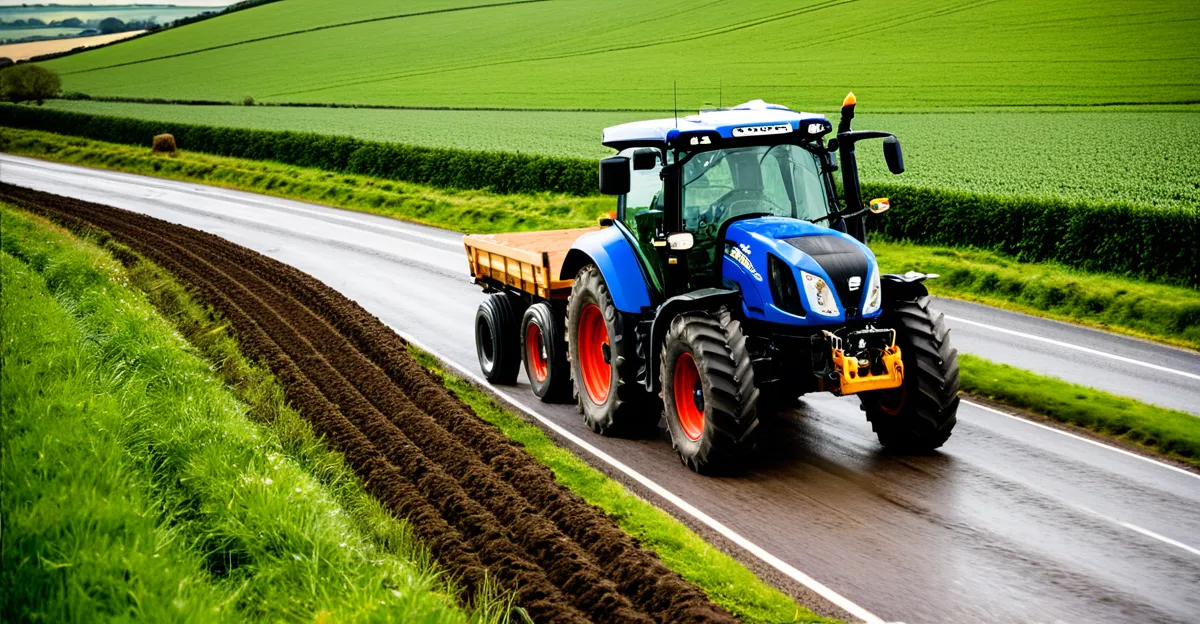Essential UK Road Safety Guidelines for Farm Vehicles
Understanding UK road safety guidelines for farm vehicles is crucial for protecting drivers and the public. Farm vehicle safety on public roads is governed by official guidelines that address specific requirements to enhance visibility, stability, and control. These guidelines ensure agricultural machinery meets standards such as appropriate lighting, reflectors, and speed limitations before operating on roads.
Compliance with government safety standards is vital to reduce accidents involving farm vehicles. These standards mandate periodic inspections and proper maintenance to keep vehicles roadworthy. For example, slow-moving farm vehicles must display warning signs and use flashing amber lights to alert other road users.
Also to discover : Comprehensive guide to brake fluid changes: expert timing advice for drivers in bustling uk cities
Agricultural vehicles differ from regular vehicles in several key ways. They often travel at lower speeds but are larger and less manoeuvrable. Hence, they require additional caution when joining or crossing traffic. The official guidelines emphasize driver vigilance and adherence to specific rules, such as yielding priority and restricting road use to daylight or good weather conditions for safer travel.
By following these targeted UK road safety guidelines, farmers and transporters enhance safety for all road users while complying with the law.
In parallel : Exploring uk traffic laws: the impact of dashcams on driving regulations
Key UK Regulations for Operating Farm Vehicles
Understanding UK farm vehicle regulations is essential for safe and lawful operation. The official road rules set clear legal speed limits for these vehicles. Typically, farm vehicles must not exceed 20 mph on public roads, ensuring safety for both operators and other road users. Exceeding these limits can result in penalties.
Lighting, reflectors, and signage are mandatory under farm vehicle laws. Vehicles must be equipped with rear-facing red lamps and amber flashing beacons when traveling on public roads. Reflective markings enhance visibility, especially in low light or poor weather, aligning with safety requirements.
Licensing and operator requirements also fall under UK law. Drivers of most farm vehicles require a valid Category F licence or an equivalent, depending on the vehicle weight and type. Operators must adhere to these stipulations to comply with legal responsibilities.
Compliance with these UK farm vehicle regulations not only promotes road safety but avoids fines and legal complications. Familiarity with these rules empowers farmers to use their machinery responsibly on public roads, optimizing both safety and efficiency.
Safe Road Sharing Practices with Agricultural Vehicles
Sharing roads with farm vehicles requires attentive driving and respect for their unique characteristics. Agricultural vehicles often move slower and may make wide turns, so maintaining safe distances is crucial. Drivers should allow extra space behind these vehicles to accommodate sudden stops or slow movements, enhancing rural traffic safety.
When overtaking farm equipment, ensure there’s ample clear road ahead. Use signals early and avoid passing on narrow or blind curves. Patience is key; rushing increases risks for both parties. Agricultural vehicle best practices emphasize visibility—farmers often use flashing lights or slow-moving vehicle emblems, which you should recognize as cues to adjust your speed accordingly.
During peak agricultural seasons, roads see increased traffic of large machinery. Awareness of these seasonal patterns helps drivers anticipate delays and potential hazards. Planning routes and travel times to avoid busy periods supports safer road sharing.
Ultimately, rural traffic safety hinges on understanding and adapting to the slower pace and size of agricultural vehicles. Respecting these elements protects everyone on the road, fosters cooperation, and smooths traffic flow in farming communities.
Identifying and Managing Common Hazards
Understanding road hazards agricultural vehicles pose is crucial for UK rural road safety. Farm machinery, like tractors, often moves slower than regular traffic and can make unexpected manoeuvres such as wide turns or sudden stops. Being alert to these behaviours improves hazard awareness and reduces collision risks.
To anticipate tractor movements effectively, watch for slow-moving vehicle signs and be patient. Maintain a safe distance, especially since agricultural vehicles may need extra space to turn or reverse. Visibility can be limited due to size or attached equipment, so always approach with caution.
If you encounter a road hazard involving agricultural vehicles, it’s important to report it promptly to local authorities. This ensures timely responses and helps prevent further incidents. In cases of accidents or near misses, note down details like location, time, and vehicle characteristics for accurate reporting.
By enhancing hazard awareness and following safe driving tips, you contribute to safer UK rural road conditions, protecting both farm workers and other road users alike.
Legal Responsibilities and Staying Updated
Understanding legal obligations for farm vehicles is crucial for operators and landowners. Farm vehicle operators must ensure their vehicles comply with UK road safety standards, including proper registration, insurance, and adherence to weight and speed limits. Landowners share responsibility for maintaining safe access routes and verifying that vehicles meet regulatory requirements.
Recent UK legislation updates emphasize stricter enforcement of vehicle standards and enhanced safety measures, particularly for machinery operating on public roads. Staying current with these changes helps prevent costly fines or legal issues. For example, new policies affecting agricultural transport may involve updated lighting and visibility requirements or restrictions on vehicle size and load.
To remain compliant, regularly check official government sources and reputable agricultural organizations for the latest information on compliance and enforcement. These resources provide timely updates on legislation and practical advice for farm vehicle operators. Accessing official updates ensures that responsibilities are met effectively, fostering safer agricultural transport across the UK countryside.
